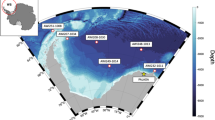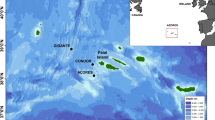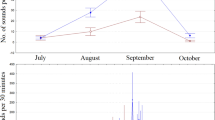Abstract
Background noise can interfere with the detection and discrimination of crucial signals among members of a species. Here we investigate the vocal behaviour in the presence and absence of whale-watcher boat traffic of three social groups (pods) of killer whales (Orcinus orca) living in the nearshore waters of Washington state. We find longer call durations in the presence of boats for all three pods, but only in recent recordings made following a period of increasing boat traffic. This result indicates that these whales adjust their behaviour to compensate for anthropogenic noise once it reaches a threshold level.
Similar content being viewed by others
Main
Killer whales are the largest of the dolphin species and are highly social, living in matrifocal pods whose membership is stable over decades1. The vocal repertoire of whales in our study region shows pod-specific dialects, and there is a single primary call for each pod that represents up to 52% of the sounds produced by that pod2.
We analysed the primary calls from each of the three pods that make up the collection of killer whales known as the southern resident community. Strategies that could be used by the whales to overcome interference from background noise include increasing the frequency, amplitude and duration of their signals. For example, humpback whales lengthen their song duration during playback of low-frequency active sonar3; and an improvement in perception threshold due to increased signal duration (in the context of the time required to integrate the signal) has been demonstrated in many species4.
Today's southern resident population of killer whales is exposed to intense whale-watching activity (Fig. 1). This is associated with considerable boat engine noise — there is typically a fleet of 72 commercial vessels and an average of 22 boats following a pod during daylight hours. The number of boats has increased over the past decade and the population has been in decline since 1996 (Fig. 2). Southern resident killer whales may coordinate at least some aspects of cooperative foraging with their repertoire of discrete calls2,5, and theoretical assessments6,7 indicate that boat noise could impair communication between killer whales over a range of 1–14 km.
a, Boat and whale numbers are shown for the period between 1973 and 2003. Solid line, size of whale population; blue bars, number of active commercial boats per year; red bars, average number of boats following whales, measured from shore base (Lime Kiln Lighthouse, San Juan Island, Washington state; data for 1990–2003 only); yellow bars, average number of vessels following whales, measured using boat-based observations (1998–2003 only). b, Call duration in seconds for the three pods (termed J, K and L) recorded in the presence (black) and absence (white) of boats for each time period (error bars show 1 s.d.).
We compared recordings (for methods, see supplementary information) made in the presence or absence of boat noise during three time periods: 1977–81, 1989–92 and 2001–03 (some recordings provided by K. C. Balcomb). We found no significant difference in the duration of primary calls2 in the presence or absence of boats for the first two periods, but a significant increase (about 15%) in call duration for all three pods in the presence of boats during the 2001–03 period (J pod: for t-test t = 4.13, for Mann–Whitney U-test z = 4.09, P < 0.0001, d.f. = 134; K pod: t = 4.33, z = 3.36, P < 0.0008, d.f. = 162; L pod: t = 3.14, z = 2.97, P < 0.005, d.f. = 192; see Fig. 2).
All comparisons of call rate were non-significant (and data were not available for an assessment of call amplitude). Functional differences between the repetition rate of calls and their duration may explain the lack of correlation for repetition rate, although we have no direct evidence for this. The average number of vessels attending the whales increased roughly fivefold from 1990 to 2000, suggesting that there is a threshold level of disturbance beyond which ‘anti-masking’ behaviour, such as increased signal duration, begins.
Structural changes have been found previously in the songs of birds and humpback whales in environments altered by humans3,8, but our findings show a response that seems to be initiated to counteract anthropogenic noise only once it reaches a critical level.
References
Bigg, M. A. et al. IWC Special Issue 12, 383–405 (1990).
Hoelzel, A. R. & Osborne, R. W. in Behavioural Biology of Killer Whales (eds Kirkevold, B. & Lockard, J. S.) 373–403 (Liss, New York, 1986).
Miller, P. J. O. et al. Nature 405, 903 (2000).
Heil, P. & Neubauer, H. Proc. Natl Acad. Sci. USA 100, 6151–6156 (2003).
Hoelzel, A. R. Anim. Behav. 45, 581–591 (1993).
Bain, D. E. & Dahlheim, M. E. in Marine Mammals and the Exxon Valdez (ed. Loughlin, T. R.) 243–256 (Academic Press, San Diego, 1994).
Erbe, C. Mar. Mamm. Sci. 18, 394–418 (2002).
Slabbekoorn, H. & Peet, M. Nature 424, 267 (2003).
Author information
Authors and Affiliations
Corresponding author
Ethics declarations
Competing interests
The authors declare no competing financial interests.
Supplementary information
Supplementary Information
Contains supplementary methods and table showing details of data analyses. (DOC 59 kb)
Rights and permissions
About this article
Cite this article
Foote, A., Osborne, R. & Hoelzel, A. Whale-call response to masking boat noise. Nature 428, 910 (2004). https://doi.org/10.1038/428910a
Issue Date:
DOI: https://doi.org/10.1038/428910a
This article is cited by
-
Spatial release from masking in crocodilians
Communications Biology (2022)
-
The impact of anthropogenic noise on individual identification via female song in Black-capped chickadees (Poecile atricapillus)
Scientific Reports (2021)
-
Communication breakdown: Limits of spectro-temporal resolution for the perception of bat communication calls
Scientific Reports (2021)
-
Long-term and persistent vocal plasticity in adult bats
Nature Communications (2019)
-
Alarm call modification by prairie dogs in the presence of juveniles
Journal of Ethology (2019)
Comments
By submitting a comment you agree to abide by our Terms and Community Guidelines. If you find something abusive or that does not comply with our terms or guidelines please flag it as inappropriate.





